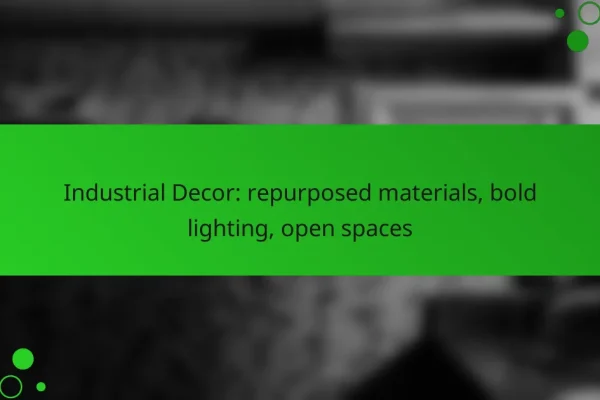What are the latest decor style trends in the UK?
The latest decor style trends in the UK emphasize sustainability, simplicity, and a blend of old and new elements. Homeowners are increasingly drawn to designs that enhance well-being, incorporate technology, and make bold aesthetic statements.
Biophilic design
Biophilic design focuses on connecting indoor spaces with nature, promoting well-being and tranquility. This trend often includes elements like natural materials, indoor plants, and ample natural light. Incorporating biophilic elements can enhance air quality and reduce stress, making homes feel more inviting.
To implement biophilic design, consider adding large windows, green walls, or indoor gardens. Using materials such as wood and stone can also create a more organic feel in your living space.
Minimalist aesthetics
Minimalist aesthetics prioritize simplicity and functionality, often featuring clean lines and a limited color palette. This trend encourages decluttering and focusing on essential items, creating a serene and organized environment. Minimalism can make spaces appear larger and more open.
To achieve a minimalist look, choose furniture with simple shapes and avoid excessive decoration. Stick to a few key pieces that serve multiple purposes, such as a coffee table that doubles as storage.
Vintage revival
The vintage revival trend embraces retro styles and nostalgic elements, often incorporating furniture and decor from past decades. This approach allows homeowners to express their personality while adding character to their spaces. Vintage pieces can be sourced from thrift shops, flea markets, or online marketplaces.
Mixing vintage items with modern decor can create a unique aesthetic. Consider pairing a mid-century sofa with contemporary artwork to achieve a balanced look.
Smart home integration
Smart home integration involves incorporating technology into home decor to enhance convenience and efficiency. This trend includes smart lighting, thermostats, and security systems that can be controlled via smartphones or voice assistants. Smart technology can improve energy efficiency and provide added security.
When integrating smart devices, ensure they blend seamlessly with your decor. Choose smart appliances that match your kitchen style or smart lighting that complements your interior design.
Bold color palettes
Bold color palettes are making a comeback, with homeowners opting for vibrant hues to make statements in their spaces. This trend encourages the use of rich colors like deep blues, greens, and warm reds to create focal points and evoke emotions. Accent walls and colorful furniture can transform a room’s atmosphere.
To effectively use bold colors, consider starting with one or two accent pieces and gradually incorporating more. Balance vibrant colors with neutral tones to prevent overwhelming the space.
How can I incorporate these trends into my home?
Incorporating current decor style trends into your home involves selecting elements that resonate with your personal taste while enhancing your living space. Focus on integrating natural materials, functional furniture, and vibrant colors to create a cohesive and inviting atmosphere.
Using plants for biophilic design
Biophilic design emphasizes the connection between nature and indoor spaces. Incorporating plants not only improves air quality but also enhances mood and productivity. Consider using a variety of plants, such as succulents, ferns, and snake plants, to create a lush environment.
Choose locations with adequate light and humidity for your plants. Hanging planters or wall-mounted shelves can save space while adding visual interest. Aim for a mix of sizes and textures to create a dynamic look.
Choosing minimalist furniture
Minimalist furniture focuses on simplicity and functionality, making it ideal for modern homes. Look for pieces with clean lines and neutral colors that can blend seamlessly into your decor. Prioritize quality over quantity to avoid clutter.
When selecting furniture, consider multi-functional items, such as a coffee table with storage or a sofa bed. This approach maximizes space and maintains an uncluttered aesthetic. Stick to a few key pieces to maintain a balanced look.
Finding vintage decor pieces
Incorporating vintage decor adds character and uniqueness to your home. Explore local thrift stores, flea markets, or online marketplaces for one-of-a-kind finds that reflect your style. Look for items like antique mirrors, retro lamps, or classic artwork.
When integrating vintage pieces, ensure they complement your existing decor. A well-placed vintage item can serve as a focal point, enhancing the overall aesthetic. Be mindful of the condition and authenticity of vintage items to ensure longevity.
Integrating smart technology
Smart technology can enhance convenience and efficiency in your home. Consider installing smart lighting, thermostats, or security systems that can be controlled via smartphone apps. This integration allows for customization and energy savings.
When selecting smart devices, ensure compatibility with your existing home systems. Look for user-friendly options that offer reliable performance. Regularly update software to maintain security and functionality.
Applying bold colors effectively
Bold colors can energize a space and express personal style. When using vibrant hues, consider accent walls or statement furniture pieces to create focal points without overwhelming the room. Pair bold colors with neutral tones for balance.
Test paint colors in small areas before committing to a full application. Use color swatches to visualize how different shades interact with your lighting. Remember that the right combination can transform the mood of your space dramatically.
What are the best decor styles for small spaces?
The best decor styles for small spaces focus on maximizing functionality while maintaining a sense of openness and style. Popular choices include Scandinavian style, open concept layouts, and multi-functional furniture, all designed to create an inviting atmosphere without overwhelming the area.
Scandinavian style
Scandinavian style is characterized by minimalism, functionality, and a light color palette. This approach emphasizes natural light and often incorporates white walls, wooden floors, and simple furniture designs. To enhance a small space, choose pieces that are sleek and avoid heavy ornamentation.
Incorporating plants and textiles can add warmth and texture without cluttering the space. Consider using light-colored furniture and decor to create an airy feel, making the area appear larger than it is.
Open concept layouts
Open concept layouts remove barriers between rooms, creating a seamless flow that makes small spaces feel more expansive. This design approach encourages natural light to travel throughout the area, enhancing the overall ambiance. When planning an open layout, focus on defining spaces with furniture arrangements rather than walls.
Use rugs or lighting to delineate different functional areas, such as living and dining spaces. This method not only maximizes space but also fosters social interaction, making it ideal for small homes.
Multi-functional furniture
Multi-functional furniture is essential for small spaces, as it serves multiple purposes while saving space. Look for items like sofa beds, storage ottomans, or extendable dining tables that can adapt to your needs. These versatile pieces help maintain a tidy environment while providing necessary functionality.
When selecting multi-functional furniture, consider the quality and durability to ensure it withstands regular use. Prioritize designs that blend seamlessly with your decor style, enhancing both utility and aesthetics in your small space.
What are the key factors to consider when selecting decor?
When selecting decor, it’s essential to consider personal style, budget constraints, and space functionality. These factors will guide your choices and ensure that your decor aligns with your preferences and practical needs.
Personal style
Your personal style is a reflection of your tastes and preferences, which should guide your decor choices. Consider what colors, patterns, and materials resonate with you, whether it’s modern, traditional, or eclectic. Look for inspiration in design magazines, online platforms, or even nature to help define your aesthetic.
To maintain coherence in your decor, choose a few key elements that represent your style and build around them. This could include statement pieces like artwork or furniture that serve as focal points in your space.
Budget constraints
Budget constraints are a critical factor when selecting decor, as they determine what you can realistically afford. Establish a clear budget before you start shopping, and prioritize your spending on essential items. Consider allocating funds for high-impact pieces while opting for more affordable options for accessories.
Keep in mind that decor doesn’t always have to be expensive. Thrift stores, online marketplaces, and DIY projects can offer unique finds that fit within your budget while allowing for personal expression.
Space functionality
Space functionality refers to how well your decor supports the intended use of a room. Assess the layout and size of your space to ensure that your decor enhances its usability. For example, in a small living area, choose multi-functional furniture that maximizes space without sacrificing style.
Additionally, consider the flow of movement within the space. Avoid overcrowding with too many decorative items, as this can hinder functionality and make the area feel cramped. Aim for a balance between aesthetics and practicality to create a comfortable environment.
How do decor innovations impact sustainability?
Decor innovations significantly enhance sustainability by introducing new materials and methods that reduce environmental impact. These advancements often focus on minimizing waste, using renewable resources, and promoting energy efficiency in design.
Use of eco-friendly materials
Eco-friendly materials are crucial for sustainable decor, as they reduce harm to the environment during production and disposal. Options like bamboo, reclaimed wood, and recycled metals are popular choices that not only lower carbon footprints but also offer unique aesthetics.
When selecting eco-friendly materials, consider certifications such as FSC (Forest Stewardship Council) for wood products or GOTS (Global Organic Textile Standard) for textiles. These labels ensure that materials meet specific environmental and social criteria.
Incorporating eco-friendly materials into your decor can be straightforward. Start with small changes, like using organic cotton for cushions or choosing furniture made from sustainably sourced wood. This approach allows you to gradually enhance sustainability in your space without overwhelming your budget.










